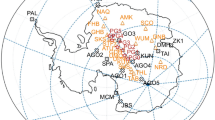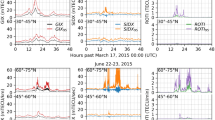Abstract
The International GNSS Service (IGS) has recently accepted for official release a new ionospheric product to characterize ionospheric irregularity and intensity as derived from multi-site ground-based GPS observations. This product was developed and implemented in the Space Radio-Diagnostic Research Center (SRRC), University of Warmia and Mazury. The SRRC has implemented this approach using in-house software for multi-step processing and interpretation of carrier phase delays in dual-frequency GPS signals and provides the new product to the IGS database. We used measurements with 30-s sampling rate from about 700 GPS stations located at high and middle latitudes of the Northern Hemisphere. The product represents changes in the GPS-based Rate of TEC Index (ROTI) and has a polar projection within a range of 50°–90°N in geomagnetic latitude and 00–24 magnetic local time. The new service allows regular monitoring of ionospheric irregularities over the Northern Hemisphere. We demonstrate results of visualization and analysis of the IGS ROTI Maps product for representative periods with geomagnetically quiet conditions and severe geomagnetic storms in 2014–2015 in order to demonstrate the performance and ability of this product to depict the development of ionospheric irregularities in the area of interest. During space weather events, the ionospheric irregularities oval, as deduced from the ROTI Maps, expands significantly in size toward midlatitudes with simultaneous increase in irregularities intensity, which can lead to degradation of the GPS precise positioning performance at lower latitudes.





Similar content being viewed by others

Explore related subjects
Discover the latest articles, news and stories from top researchers in related subjects.References
Afraimovich EL, Perevalova NP (2006) GPS- monitoring of the Earth upper atmosphere. SC RRS SB RAMS, Irkutsk, Russia
Akasofu SI (1964) The development of the auroral substorm. Planet Space Sci 12(4):273–282. https://doi.org/10.1016/0032-0633(64)90151-5
Akasofu SI (1966) The auroral oval, the auroral substorm, and their relations with the internal structure of the magnetosphere. Planet Space Sci 14(7):587–595
Béniguel Y et al (2017) MONITOR Ionospheric Network: two case studies on scintillation and electron content variability. Ann Geophys 35:377–391. https://doi.org/10.5194/angeo-35-377-2017
Blewitt G (1990) An automatic editing algorithm for GPS data. Geophys Res Lett 17:199–202
Cherniak I, Zakharenkova I (2016) First observations of super plasma bubbles in Europe. Geophys Res Lett 43(21):11137–11145. https://doi.org/10.1002/2016GL071421
Cherniak Iu, Krankowski A, Zakharenkova I (2014) Observation of the ionospheric irregularities over the Northern Hemisphere: methodology and service. Radio Sci 49(8):653–662. https://doi.org/10.1002/2014RS005433
Cherniak Iu, Zakharenkova I, Redmon R (2015) Dynamics of the high-latitude ionospheric irregularities during the March 17, 2015 St. Patrick’s Day storm: ground-based GPS measurements. Space Weather 13(9):585–597. https://doi.org/10.1002/2015SW001237
Crowley G (1996) Critical review of ionospheric patches and blobs. In: Stone WR (ed) Review of radio science 1993–1996, URSI, Oxford University Press, pp 619–648
Doherty P, Coster AJ, Murtagh W (2004) Eye on the ionosphere: space weather effects of October–November 2003. GPS Solut 8(4):267–271. https://doi.org/10.1007/s10291-004-0109-3
Fejer BG, Kelley MC (1980) Ionospheric irregularities. Rev Geophys Space Phys 18(2):401–454. https://doi.org/10.1029/RG018i002p00401
Feldstein YI (1973) Auroral oval. J Geophys Res 78(7):1210–1213. https://doi.org/10.1029/JA078i007p01210
Foster JC (1993) Storm time plasma transport at middle and high latitudes. J Geophys Res 98(A2):1675–1689. https://doi.org/10.1029/92JA02032
Foster JC, Burke WJ (2002) SAPS: a new categorization for sub-auroral electric fields. EOS 83:393–394
Foster JC, Vo HB (2002) Average characteristics and activity dependence of the subauroral polarization stream. J Geophys Res 107:1475. https://doi.org/10.1029/2002JA009409
Hatch R (1982) The synergism of GPS code and carrier measurements. In: Proceedings of the third international symposium on Satellite Doppler Positioning at Physical Sciences Laboratory of New Mexico State University, vol 2, pp 1213–1231
Horvath I, Crozier S (2007) Software developed for obtaining GPS-derived total electron content values. Radio Sci 42:RS2002. https://doi.org/10.1029/2006RS003452
Jakowski N, Mielich J, Borries C, Cander L, Krankowski A, Nava B, Stankov SM (2008) Large-scale ionospheric gradients over Europe observed in October 2003. J Atmos Sol-Terr Phys 70(15):1894–1903. https://doi.org/10.1016/j.jastp.2008.03.020
Jiao Y, Morton YT, Taylor S, Pelgrum W (2013) Characterization of high-latitude ionospheric scintillation of GPS signals. Radio Sci 48(6):698–708. https://doi.org/10.1002/2013RS005259
Kamide Y, Kusano K (2015) No major solar flares but the largest geomagnetic storm in the present solar cycle. Space Weather 13(6):365–367. https://doi.org/10.1002/2015SW001213
Kelley MC, Vickrey JF, Carlson CW, Torbert R (1982) On the origin and spatial extent of high-latitude F region irregularities. J Geophys Res 87(A6):4469–4475
Kelly MA, Comberiate JM, Miller ES, Paxton LJ (2014) Progress toward forecasting of space weather effects on UHF SATCOM after Operation Anaconda. Space Weather 12(10):601–611. https://doi.org/10.1002/2014SW001081
Keskinen MJ, Ossakow SL (1983) Theories of high-latitude ionospheric irregularities: a review. Radio Sci 18(6):1077–1091. https://doi.org/10.1029/RS018i006p01077
Krankowski A et al (2016) Ionosphere Working Group Technical Report 2015 in the International GNSS Service Technical Report 2015 (IGS Annual Report). IGS Central Bureau and University of Bern; Bern Open Publishing. https://doi.org/10.7892/boris.80307
Lassen K (1967) Polar cap aurora. In: McCormac BM (ed) Aurora and airglow. Reinhold, New York, pp 453–464
Ledvina BM, Makela JJ, Kintner PM (2002) First observations of intense GPS L1 amplitude scintillations at midlatitude. Geophys Res Lett 29(14):1659. https://doi.org/10.1029/2002GL014770
Liu J, Wang W, Burns A, Yue X, Zhang S, Zhang Y, Huang C (2015) Profiles of ionospheric storm-enhanced density during the 17 March 2015 great storm. J Geophys Res Space Phys 121(1):727–744. https://doi.org/10.1002/2015JA021832
Melbourne WG (1985) The case for ranging in GPS based geodetic systems. In: Proceedings of the 1st international symposium on precise positioning with the global positioning system, Rockville, pp 373–386
Mitchell CN, Alfonsi L, De Francesci G, Lester M, Romano V (2004) GPS TEC and scintillation measurements from the polar ionosphere during the October 2003 storm. Geophys Res Lett 32:L12S03. https://doi.org/10.1029/2004GL021644
Newell PT, Liou K, Zhang Y, Sotirelis T, Paxton LJ, Mitchell EJ (2014) OVATION Prime-2013: extension of auroral model to higher disturbance levels. Space Weather 12(6):368–379. https://doi.org/10.1002/2014SW001056
Phelps ADR, Sagalyn RC (1976) Plasma density irregularities in the high-latitude top side ionosphere. J Geophys Res 81(4):515–523. https://doi.org/10.1029/JA081i004p00515
Pi X, Mannucci A, Lindqwister UJ, Ho CM (1997) Monitoring of global ionospheric irregularities using the worldwide GPS network. Geophys Res Lett 24(18):2283–2286
Pi X, Mannucci AJ, Valant-Spaight B, Bar-Sever Y, Romans LJ, Skone S, Sparks L, Martin Hall G (2013) Observations of global and regional ionospheric irregularities and scintillation using GNSS tracking networks. In: Proceedings of the ION 2013, Pacific PNT Meeting, Honolulu, pp 752–761
Pi X, Mannucci AJ, Valant-Spaight B, Viereck R, Zhang Y (2016) Middle-latitude ionospheric irregularities and scintillation during geomagnetic storms. In: Proceedings of ION GNSS + 2016, Portland, pp 1657–1663
Pi X, Iijima BA, Lu W (2017) Effects of ionospheric scintillation on GNSS-based positioning. J Inst Navig 64(1):3–22. https://doi.org/10.1002/navi.182
Prikryl P, Ghoddousi-Fard R, Kunduri BSR, Thomas EG, Coster AJ, Jayachandran PT, Spanswick E, Danskin DW (2013) GPS phase scintillation and proxy index at high latitudes during a moderate geomagnetic storm. Ann Geophys 31:805–816. https://doi.org/10.5194/angeo-31-805-2013
Roy B, Dasgupta A, Paul A (2014) Impact of space weather events on satellite-based navigation. Space Weather 11(12):680–686. https://doi.org/10.1002/2013SW001001
Skone S, Cannon ME (1995) Ionospheric effects on differential GPS applications during auroral substorm activity. ISPRS J Photogram Remote Sens 54:279–288
Skone S, Feng M, Ghafoori F, Tiwari R (2008) Investigation of scintillation characteristics for high latitude phenomena. In: Proceedings of ION GNSS, Savannah, pp 2425–2433
Tsunoda RT (1988) High-latitude F region irregularities: a review and synthesis. Rev Geophys 26(4):719–760
Vo HB, Foster JC (2001) A quantitative study of ionospheric density gradients at midlatitudes. J Geophys Res 106(A10):21555–21563. https://doi.org/10.1029/2000JA000397
Wanner B (2015) DR #127: effect on WAAS from Iono Activity on March 17–18, 2015, WAAS Technical Report at the WAAS Test Team web-page. http://www.nstb.tc.faa.gov
Weber EJ, Buchau J, Moore JG, Sharber JR, Livingston RC, Winningham JD, Reinisch BW (1984) F layer ionization patches in the polar cap. J Geophys Res 89(A3):1683–1694. https://doi.org/10.1029/JA089iA03p01683
Wübbena G (1985) Software developments for geodetic positioning with GPS using TI 4100 code and carrier measurements. In: Proceedings of the 1st international symposium on precise positioning with the global positioning system, Rockville, pp 403–412
Acknowledgements
We acknowledge the use of the raw GNSS data provided by IGS (ftp://cddis.gsfc.nasa.gov/pub/gps/), UNAVCO (ftp://data-out.unavco.org), CORS (ftp://geodesy.noaa.gov), EPN (ftp://igs.bkg.bund.de/euref/obs). Irina Zakharenkova was in part supported by the Russian Foundation for Basic Research Grant No. 16-05-01077. Iurii Cherniak was in part supported by the National Science Foundation CAS AGS-1033112 Grant. Data for interplanetary and geophysical parameters were provided by the NASA/GSFC’s Space Physics Data Facility’s OMNIWeb service. The Kp index data were obtained from the GFZ International Kp index Service (www.gfz-potsdam.de/en/section/earths-magnetic-field/data-products-services/kp-index/qd-days/qd-days-since-2010).
Author information
Authors and Affiliations
Corresponding author
Rights and permissions
About this article
Cite this article
Cherniak, I., Krankowski, A. & Zakharenkova, I. ROTI Maps: a new IGS ionospheric product characterizing the ionospheric irregularities occurrence. GPS Solut 22, 69 (2018). https://doi.org/10.1007/s10291-018-0730-1
Received:
Accepted:
Published:
DOI: https://doi.org/10.1007/s10291-018-0730-1



